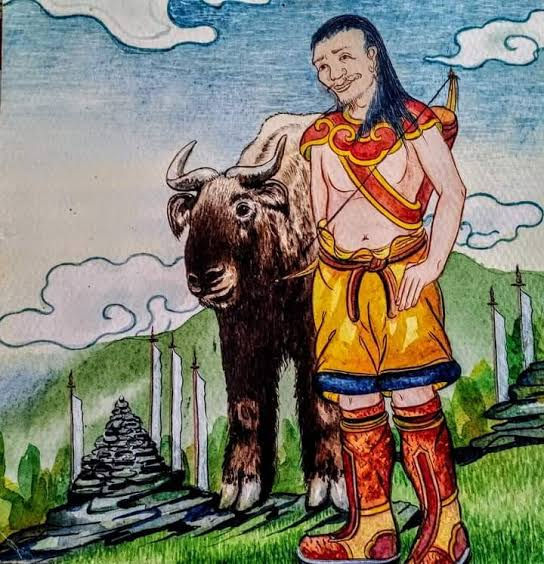What is Dong Gyem Tseys?
Dong Gyem Tsey, also known as "takins," are mammals found in the Himalayan regions of Bhutan, China, and Nepal. They are seen in groups of families in sparse, cold rural areas. During summer, herds assemble high on the mountain slopes, and they frequently feed on plants near rocky grounds with salty areas such as around hot springs. They graze on a variety of leaves, grasses, bamboo shoots, and flowers in the early morning and late afternoon while standing on their hind legs. Takins are ruminants, like cows and sheep, and they swallow food before passing it into the rumen, their first stomach. Small food particles are digested by microbes in the rumen. Takins migrate from the upper grassland to the lower grassland in the winter, towards more forested areas. They also prefer sunny areas during sunrise.

A picture of Takin on a rocky hill in Bhutan.
Picture courtesy: https://www.littlebhutan.com/blogs/the-legend-behind-the-takin-bhutans-national-animal.html
Other than bears, wolves, leopards, and dholes, takins have few natural adversaries due to their huge, strong bodies and magnificent horns. They move slowly in general but can act swiftly when enraged or scared. Takins can nimbly leap from rock to rock when necessary. They use a loud "cough" to alert other animals to danger, which causes the herd to flee for safety in the underbrush and lay down to hide from predators. Takins can also yell or growl in a menacing manner.
In terms of appearance, it is furry with a wide, broad face, small ears, a bulbous nose, and has horns that point backwards. It also has slumped shoulders, a short, thick neck, and short but muscular legs. It almost looks like a mixture of moose, bear, bison and goat. Intriguingly, Bhutan follows a historical myth of Takins and its existence that traces its roots back to magical creations of a Tibetan saint Lam Drukpa Kuenley who is also known as the “Divine Mad Man”.
Tales of Dong Gyem Tsey:
Legends has it that around 15th- 16th century, Lam Drukpa Kuenley a folk hero in Bhutan, created this animal from bone fragments of cows and goats. It is believed that when local people requested him to perform a magic, he asked for a heavy feast that included an entire body of a cow and goat as meat. Locals offered him food as asked. After he ate the meat, the Divine Mad Man is said to have miraculously joined the bony head of the goat onto the body of the cow, chanted few mantras and created a new animal. This creature is then said to have risen up alive and grazed on pastures like any other herbivorous mammal. The animal was later named as “Dong Gyem Tsey” by the saint.
A painting fo the Tibetan saint Lam Drukpa Kuenley with a Takin

Picture courtesy: https://m.facebook.com/109698974233246/posts/lama-drukpa-kunley-created-takin-in-shar-luetshogang-present-day-shar-samtengang/149494250253718/
Importance of Takins in Bhutan:
Due to its own special and distinctive traits that resemble a charming cross between a cow and a goat, Takins in Bhutan are regarded as one of the country’s national symbols. These peculiar-looking animals are threatened species of the goat-antelope family due to overhunting and habitat fragmentation. Bhutanese people hunt takin for consumption of their meat. Takins are also kept as pets by the locals in the community. The fact that Bhutanese people like takins as pets and food supplements makes it all too clear why the takins are regarded as Bhutan's national animal. You may be able to spot a few of these creatures in the Takin Reserve Park located in Mothithang in Thimphu, Bhutan.

Royal Takin Reserve in Mothithang, Thimphu, Bhutan. Picture courtesy: https://www.bookmytour.bt/attractions/motithang-takin-preserve
Comentarios